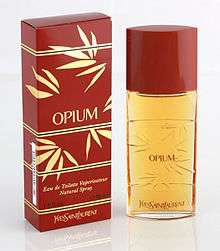Opium (perfume)
| Opium | |
|---|---|
 | |
| Fragrance by Yves Saint Laurent | |
| Released | 1977 |
| Label | Yves Saint Laurent |
| Flanker(s) |
Opium pour Homme Belle d'Opium |
Opium is an Oriental-spicy[1] perfume created for fashion brand Yves Saint Laurent (YSL) by perfumer Jean Amic and Jean-Louis Sieuzac of Roure, first marketed in 1977.[2] Its top notes are a mixture of fruit and spices, with mandarin orange,[3] plum, clove, coriander and pepper,[2] as well as bay leaf.[4] Its floral middle notes consist predominantly jasmine, rose and Lily of the Valley,[2] in addition to carnation, cinnamon, peach and orris root.[4] It is underlined by the sweet woody base note containing sandalwood, cedarwood, myrrh, opopanax, labdanum, benzoin and castoreum,[2] in addition to amber, incense, musk, patchouli, tolu and vetiver.[4]
Naming and theme
Opium caused a stir with its controversial name and brought accusations that brand designer Yves Saint Laurent was condoning drug use.[5] In the United States, a group of Chinese Americans demanded a change of the name and a public apology from Saint Laurent for "his insensitivity to Chinese history and Chinese American concerns." They formed a committee called the American Coalition Against Opium and Drug Abuse, which expressed outrage at the choice of a name representing "a menace that destroyed many lives in China."[6] But such controversies rather helped the perfume to be well-publicized, which soon became a best-selling scent.[4] For its launch party in 1977, a tall ship Peking was rented from the South Street Seaport Museum in New York's East Harbor, and writer Truman Capote sat at the helm of the ship at the party.[4] The ship was draped with banners of gold, red, and purple, and the Oriental theme was displayed with a 1,000-pound (450 kg) bronze statue of the Buddha, decorated with white cattleya orchids.[4] YSL carried the Oriental theme into its packaging design as well—the red plastic container holding the perfume's glass vial, designed by Pierre Dinand,[7][2] was inspired by inro (印籠, いんろう), the small Japanese lacquered cases that were worn under kimonos and held perfumes, herbs and medicines.[8]
Opium, Lilac Perfume Oil and White Musk from The Body Shop, Juniper Breeze from Bath & Body Works and Royal Secret formerly Germaine Monteil were among the perfumes tested in 2003 in a study of the relationship of scents to memory.[9]
Ad campaign controversy
A poster advertising campaign for the perfume caused another controversy in October and November 2000. It featured the model Sophie Dahl lying on her back wearing only a pair of stiletto heels, seemingly in the throes of ecstasy, with her legs spread apart as she covers one of her nipples with her hand.[10] This ad compaign, photographed by Steven Meisel, was widely seen in print ads and posters in bus shelters in many countries. It won an award in Spain[11] but generated an uproar in other places, particularly in the United Kingdom. The British Advertising Standards Authority received more than 700 complaints from the public, and ordered the posters to be withdrawn on the grounds that they were too sexually suggestive, degrading to women, and likely to cause "serious or widespread offence".[12][13] American journalist Susan Faludi argued that certain perfume ad campaigns pushed "idealization of weak yielding women" to the extreme, citing the Opium advertisement as a primary example.[14]
Opium pour Homme
YSL launched the male complement Opium pour Homme in 1995, created by Jacques Cavallier of Firmenich.[15] Its main note is set by vanilla, with black currant, galangal, star anise, ginger and pepper, fusing with basic notes of cedar and Tolu balsam. Its flask was designed by Jérôme Failliant-Dumas.[15]
Commercials
In 1992 and 1999, U.S. film director David Lynch created commercials for Opium.[16]
Belle d'Opium
Another flanker, Belle d'Opium was released in 2011. Advertisements for the perfume again generated controversy.[17]
References
- ↑ Moran, Jan (2000). Fabulous Fragrances II : A Guide to Prestige Perfumes for Women and Men. Crescent House. p. 32. ISBN 0-9639065-4-2.
- 1 2 3 4 5 Groom, Nigel (1997). New Perfume Handbook - Second Edition. Springer. p. 236. ISBN 0-7514-0403-9.
- ↑ Jan Moran lists "hesperides" instead.
- 1 2 3 4 5 6 Moran, Jan (2000). Fabulous Fragrances II : A Guide to Prestige Perfumes for Women and Men. Crescent House. p. 170. ISBN 0-9639065-4-2.
- ↑ Agence France-Presse (2008-06-01). "Fashion giant Yves Saint Laurent dies at 71". Google News. Retrieved 2008-11-10.
- ↑ Friedman, Monroe (1999). Consumer Boycotts: Effecting Change Through the Marketplace and the Media. Routledge. p. 145. ISBN 0-415-92457-X.
- ↑ "Histoire de parfum : Opium". cosmopolitan.fr. Hearst Corporation. 28 May 2014. Retrieved 1 June 2014.
- ↑ Moran, Jan (2000). Fabulous Fragrances II : A Guide to Prestige Perfumes for Women and Men. Crescent House. p. 171. ISBN 0-9639065-4-2.
- ↑ Herz, Rachel S., James Eliassen, Sophia Beland, Timothy Souza (2004). "Neuroimaging evidence for the emotional potency of odor-evoked memory". Neuropsychologia. Elsevier. 42 (3): 371–378. doi:10.1016/j.neuropsychologia.2003.08.009. PMID 14670575.
- ↑ Opium advertisement, Yves Saint Laurent, at The Sophie Dahl Gallery
- ↑ Forden, Sara G. (2001). The House of Gucci. Harper Paperbacks. p. 340. ISBN 0-06-093775-0.
- ↑ Carter, Cynthia (2003). Violence and the Media. Open University Press. p. 126. ISBN 0-335-20505-4.
- ↑ 'Offensive' Opium posters to be removed, The Guardian - December 19, 2000
- ↑ Faludi, Susan (1992). Backlash: The Undeclared War Against American Women. Anchor. p. 208. ISBN 0-385-42507-4.
- 1 2 Groom, Nigel (1997). New Perfume Handbook - Second Edition. Springer. p. 237. ISBN 0-7514-0403-9.
- ↑ Rodley, Chris (2005). Lynch on Lynch. Faber & Faber. p. 309. ISBN 0-571-22018-5.
- ↑ Poulter, Sean (3 February 2011). "Yves Saint Laurent perfume advert banned for 'simulating drug use'". Daily Mail. DMG Media. Retrieved 22 November 2015.
External links
- "Yves Saint Laurent (ysl-parfums.com)". Retrieved 2007-11-11.